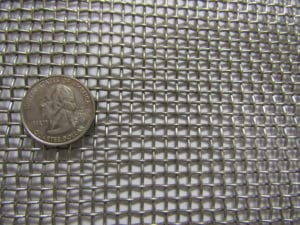Posted: 08-14-2020
Keep Your Parts Safe – Understanding Mesh Size options
 It is probably a good assumption that you are looking to buy a wire mesh basket to hold some sort of part. The most important aspect of the basket is to hold and protect those parts through your operations and therefore, the Lining or Mesh option selection is a critical step to accomplish part protection.
It is probably a good assumption that you are looking to buy a wire mesh basket to hold some sort of part. The most important aspect of the basket is to hold and protect those parts through your operations and therefore, the Lining or Mesh option selection is a critical step to accomplish part protection.
Wire mesh can come in almost infinite combinations. But thankfully, we at AnySizeBasket.com have used our many years of manufacturing experience and only made available selections that best match industry standards, commonly-used, and application specific mesh for each style of basket. Use the info (?) pop-up button on each page to get to a link or bring up a picture of each available mesh/lining option on this site. 
We can do other mesh options/sizes as a custom basket, contact us if you need such an option.
How To Decode Wire Mesh Nomenclature
First, we need to understand the mesh construction. There are two constructions: welded and woven.
Welded Wire Mesh: Cross wires are laid on top of long wires and are resistance welded together at each intersection creating very even square openings.
-
- Welded mesh usually has larger opening sizes
- Welded creates one even surface size, as all wires are straight and on the same plane
- Welded can have heavier wire gauge and typically the more rigid mesh option
Woven Wire Mesh: Wires are woven, over-under-over-under, to create the mesh.
-
- Woven is much more flexible
- Woven is great for one-piece construction of pans, bowls, or frame-less baskets
- It woven construction creates a bumpy surface feel, but allows for smaller openings.
Next we need to understand the numbers in the mesh naming: Let’s take 4 Mesh x 0.047″ woven.
The first number, “Mesh Number”, outlines the number of wires per inch. Thus, 4 Mesh has 4 wires per inch, in both directions.
The second number, “Wire Diameter”, states the size or diameter of the wire used to construct the woven or welded pattern. In our example, our wire has a diameter of 0.047″.
Lasting, the Mesh Opening Size (the holes) can be calculated by understanding the mesh size numbers listed above. So, with some simple math you can get to your opening size. Opening size of any mesh is approximately 1 inch / Mesh Number minus Wire Diameter.
Opening size = 1/(Mesh Number) minus (Wire Diameter).
In our example, the opening size is 1/4 – .047″ or .25-.047 = 0.203″.
Now…
What Size Mesh should I use?
Consider the following factors to make the best choice for your application:
- Opening Size: This is the approximate size of the square hole between the mesh wires. The opening size should be slightly smaller than the smallest part dimension. Obviously, if the mesh opening size is bigger than the parts, the parts will poke thru or fall out. On the other hand, if the mesh opening size is needlessly small, flow thru the basket will be diminished.
- Open Space Percentage: Wire mesh is used to keep something on one side while letting something else flow thru. Open Percentage measures the portion of surface area that is open, not blocked by the wires. The higher the Open Percentage, the better the flow. In general, wire mesh is more open that perforate metal for the same opening size (because the wires between the holes are thinner than the web in perforated metal)
- Wire Mesh Size Designations: Let’s take a deeper look at the effects of the mesh construction.
- Design Effects of Mesh Number (wires per inch): The Mesh Number describes how close the wires are to each other. A higher Mesh Number means the wires are tighter together, the Opening Size is smaller and the Open Percentage is lower (assuming the same wire diameter). Tightly spaced wires (higher Mesh Number) using large diameter wires creates a mesh that is extremely rigid and heavy, but expensive and difficult to work with. The opposite is also not desirable. Widely spaced wires (lower Mesh Number) using small diameter wires creates a mesh that can be difficult to work with because it’s too flimsy and the wires shift within the weave.
- Design Effects of Wire Diameter: The diameter of the wire used in the mesh contributes to the strength, rigidity, and weight of the mesh. Large diameter wires (over 0.080″) make very strong mesh, but can make a basket very heavy. Smaller diameter wires (under 0.020″) are light and very easy to work with, but can tear easily if parts are heavy with sharp corners or points.
Selecting a Mesh Size: A good rule is to start by looking for an Opening Size that will properly contain your parts, then search for the largest Open Percentage near or slightly smaller than that opening size, keeping an eye on the wire diameters of the mesh (larger is stronger but heavier)
